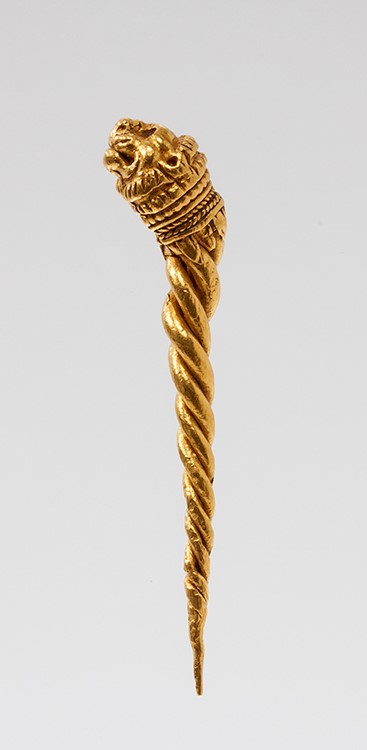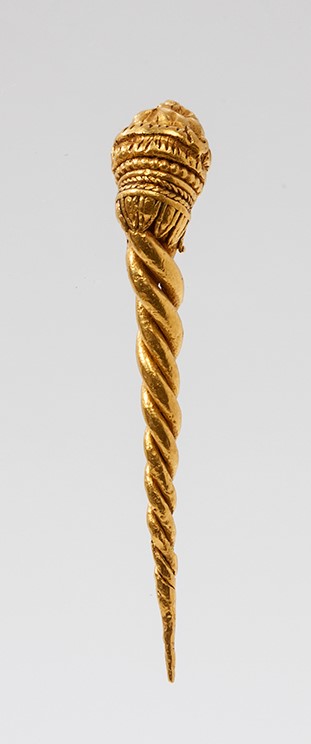Acquisition number: 1965.01
The terminal is formed by a lion-head with a filigree and beaded collar terminated at the rear by leaves; treble twisted shank.
Presumably found out of shape, the shank has been straightened instead of being bent back into a circle with the point in the lion’s mouth. It is possible that it was converted for use as a pin.
This type of earring seems to have originated in North Greece and Thrace and was introduced south through Macedonia. It became common after the time of Alexander, the lion-head terminal being particularly favoured in the late fourth and early third century BC.
Title: Gold Earring - 1965.01
Acquisition number: 1965.01
Author or editor: J.R. Green
Culture or period: Hellenistic.
Date: Late 4th - early 3rd century BC.
Material: Metal - Gold
Object type: Jewellery
Dimensions: 41mm (l)
Origin region or location: Greece
Display case or on loan: 4
Keywords: Greek, Hellenistic, Thrace, earring
Sotheby (London), Sale Cat., 19 October 1974, no. 16 and ill.; J.R. Green with B. Rawson, Catalogue of Antiquities in the Australian National University, A.N.U. (Canberra, 1981) 103; E. Bollen et al., Beauty & Betrayal. Ancient and Neo-Classical Jewellery (exhib. cat., Nicholson Museum, Sydney 2010) (Sydney 2010) 25 no 4 (colour ill.).
1965.01
Gold Earring
Purchased. Preserved length 4.lcm.
The terminal is formed by a lion-head with a filigree and beaded collar terminated at the rear by leaves; treble twisted shank.
Presumably found out of shape, the shank has been straightened instead of being bent back into a circle with the point in the lion’s mouth. It is possible that it was converted for use as a pin.
This type of earring seems to have originated in North Greece and Thrace and was introduced south through Macedonia. It became common after the time of Alexander, the lion-head terminal being particularly favoured in the late fourth and early third century BC.
For similar material, see H. Hoffmann and P. F. Davidson, Greek Gold 106 no. 26 (very close to our piece), H. Hoffmann and V. von Claer, Antiker Gold- und Silberschmuck (Mainz 1968) 113 no. 71 and 114 no. 72, and Archaeology 12, 1959, 166 fig. 4 left (from Samothrace, stratified fourth-century deposit); D. Williams and J. Ogden, Greek Gold: Jewellery of the Classical World (London 1994) 198 no. 132 (early third century). For a good general discussion, see also R.A. Higgins, Greek and Roman Jewellery (London 1961, second ed. 1980) 154-5, 161-2 and note the similar earring on pl. 47c. See also R. Laffineur, Bulletin de Correspondance Hellénique 104, 1980, 398ff.
Compare also E.D. Reeder (ed.), Hellenistic Art in the Walters Art Gallery (Baltimore 1988) nos 122-123 (ill.). M. Pfrommer, Untersuchungen zur Chronologie früh- und hochhellenistischen Goldschmucks (IstForsch 37, Tübingen 1990) 146-154 discusses and gives a basic typological sequence of lion-headed earrings. He does not include this piece. See also the range of such earrings presented by M. Dimitrova in Archeologia (Sofia) 31, 1989, 1-14, who demonstrates their popularity in Thrace.
The type is also found further west, and there is a good sample among material found in Lipari: L. Bernabò Brea and M.Cavalier (eds), Bellezza ed eleganza femminile nella Lipari greca ed ellenistica (Palermo 2005) 50-59 together with other jewellery and illustrations of its use on contemporary pottery.
The Thessalonike exhibition catalogue ΤοΕλληνικόΚόσμημα. 6,000 ΧρόνιαΠαράδοση(Exhib. Cat. Thessalonike 1997-1998, Athens 1997) includes a number of generically-similar lion-head earrings: nos 103, 122 and 130, all with colour illustrations. The Sydney exhibition catalogue mentioned in the bibliography to this piece includes a not-dissimilar pair at the University of Tasmania.
Late fourth - early third century BC.
Sotheby (London), Sale Cat., 19 October 1974, no. 16 and ill.; J.R. Green with B. Rawson, Catalogue of Antiquities in the Australian National University, A.N.U. (Canberra, 1981) 103; E. Bollen et al., Beauty & Betrayal. Ancient and Neo-Classical Jewellery (exhib. cat., Nicholson Museum, Sydney 2010) (Sydney 2010) 25 no 4 (colour ill.).


